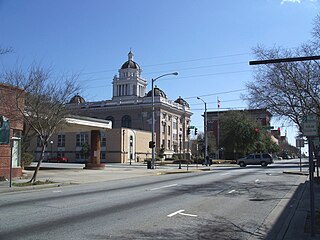
Valdosta is a city in and the county seat of Lowndes County in the U.S. state of Georgia. As the principal city of the Valdosta metropolitan statistical area, which in 2023 had a metropolitan population of 151,118, according to the US Census Bureau its metropolitan area includes Brooks County to the west. With a city population of 55,378 in 2020, Valdosta is the home of Valdosta State University, a regional university in the University System of Georgia with over 12,000 students as of 2021.

Valdosta State University is a public university in Valdosta, Georgia and is one of the four comprehensive universities in the University System of Georgia. As of 2019, VSU had over 12,000 undergraduate and graduate students. VSU also offers classes at Moody Air Force Base north of Valdosta in Lowndes County.
The architecture of the California missions was influenced by several factors, those being the limitations in the construction materials that were on hand, an overall lack of skilled labor, and a desire on the part of the founding priests to emulate notable structures in their Spanish homeland. While no two mission complexes are identical, they all employed the same basic building style.

The Gerald Ratner Athletics Center is a $51 million athletics facility within the University of Chicago campus in the Hyde Park community area on the South Side of Chicago, Illinois in the United States. The building was named after University of Chicago alumnus, Gerald Ratner. The architect of this suspension structure that is supported by masts, cables and counterweights was César Pelli, who is best known as the architect of the Petronas Towers.
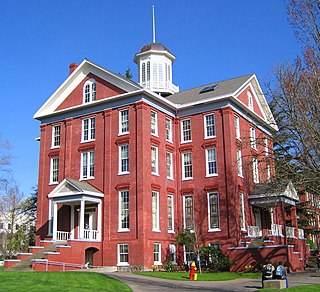
Waller Hall is a building on the campus of Willamette University in Salem, Oregon, in the United States. Opened in 1867 as University Hall, it is the oldest higher-education building west of the Mississippi River still in use, currently housing the university's administrative offices.

The Donna & Marvin Schwartz Center for Performing Arts is a 90,000-square-foot (8,400 m2) multi-discipline performing arts facility on the campus of Emory University in Atlanta, Georgia. Completed in early 2003, the Schwartz Center provides a multidisciplinary teaching and performance center for the performing arts programs at Emory including dance, music, and theater. The centerpiece of the center is the 825-seat Cherry Logan Emerson Concert Hall featuring a custom-built Daniel Jaeckel Opus 45 pipe organ with fifty-four stops and 3,605 pipes in a cherry-wood case. The concert hall was designed in part by renowned acousticians Kirkegaard and Associates. The $36.9 million structure was designed by lead architect Michael Dennis in association with Howard-Montgomery-Steger and Smallwood, Reynolds, Stewart, Stewart.

Bathhouse Row is a collection of bathhouses, associated buildings, and gardens located at Hot Springs National Park in the city of Hot Springs, Arkansas. The bathhouses were included in 1832 when the Federal Government took over four parcels of land to preserve 47 natural hot springs, their mineral waters which lack the sulphur odor of most hot springs, and their area of origin on the lower slopes of Hot Springs Mountain.

The Santa Fe Apartments were an apartment building located in Detroit, Michigan. The building was listed on the National Register of Historic Places in 1986 and subsequently demolished by Wayne State University and removed from the National Register of Historic Places in 2022. The site is now the location of the Yousif B. Ghafari Hall.
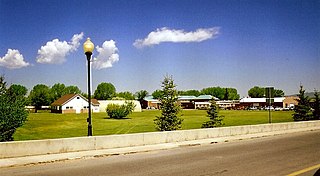
The Wyoming State Hospital, once known as the Wyoming State Insane Asylum, is located in Evanston, Wyoming, United States. The historic district occupies the oldest portion of the grounds and includes fifteen contributing buildings, including the main administrative building, staff and patient dormitories, staff apartments and houses, a cafeteria and other buildings, many of which were designed by Cheyenne, Wyoming architect William Dubois. Established in 1887, the historic buildings span the period 1907-1948. At one point it was common for new hall additions to be named after the counties in Wyoming. The recent addition of Aspen, Cottonwood, and Evergreen halls do not follow this trend.

The Wailuku Civic Center Historic District is a group of four historic buildings and one non-contributing property in Wailuku, Maui Hawaii that currently house the governmental offices of both the County of Maui and the State of Hawaii. The historic buildings were built during a time span from 1901 to 1931. They incorporate several architectural styles and two of the four historic buildings were designed and built by Hawaii-based architect C.W. Dickey. The non-contributing property houses most of the County of Maui's main offices.
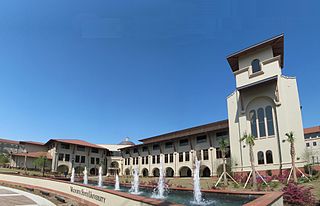
The Student Union of Valdosta State University serves as the social center of VSU and offers students a food court, bookstore, theater, game room, lounge space, and student organization offices.

The Rea and Lillian Steele North Campus is located less than a mile north of the Valdosta State University, Georgia, United States, main campus and is home to the Harley Langdale Jr. School of Business and Air Force ROTC Detachment 172. Billy Grant Field, home of the VSU baseball team, and various recreational fields are also found on the North Campus. The University’s bus service connects the two campuses.

West Hall, built in 1917, is the oldest building at Valdosta State University and features a distinctive dome and Spanish-mission architecture. It is also the center of academic activity at VSU, with numerous classrooms, departments, and offices. West Hall is named in honor of Colonel W.S. West, who as a Georgia state senator, led the legislation for the creation of a college in Valdosta through the Georgia Senate and donated the property that is now the main part of campus to the state for use by the new institution.
Valdosta State University was established in 1906 in Valdosta, Georgia. South Georgia State Normal College began as a two-year teaching college in 1913 and was an all-female school until 1950 when the name was changed to Valdosta State College. VSC experienced rapid growth in the 1960s and 70s in student population and in construction on campus. In 1993 Valdosta State achieved university status and became the second regional university in the state of Georgia. Since its founding VSU has grown into a co-educational regional university with over 12,000 students.

The Hugh C. Bailey Science Center at Valdosta State University in Valdosta, Georgia, serves as the home of the Biology and Chemistry Departments. The facility is named after former VSU President Hugh C. Bailey who served from 1978 to 2001.

The Mission Revival style was part of an architectural movement, beginning in the late 19th century, for the revival and reinterpretation of American colonial styles. Mission Revival drew inspiration from the late 18th and early 19th century Spanish missions in California. It is sometimes termed California Mission Revival, particularly when used elsewhere, such as in New Mexico and Texas which have their own unique regional architectural styles. In Australia, the style is known as Spanish Mission.
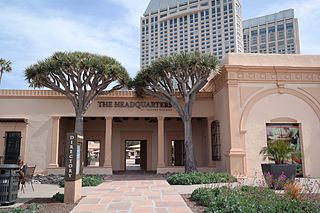
Old Police Headquarters is a historic building in San Diego, in the U.S. state of California. It was built in 1939 by Quayle. Charles & Edward (QuayleBros Treganza, Alberto Owen Golden, Morley and served as the San Diego Police Department's headquarters until 1987. The renovated buildings are now known as "The Headquarters" at Seaport Village. The building has a concrete foundation with stucco walls and has a red clay tile roof. The building's areas of significance are Architecture, Law, Politics, and Government.

The Adam Fox Building, is a historic mixed-use commercial building in Carmel-by-the-Sea, California. This building and the Schweninger Building a.k.a. Carmel Bakery, appear on the Sanborn Fire Maps for 1910. They are both unique for their second floor Victorian false-front bay windows. The two buildings are the oldest buildings that existed before the incorporation of Carmel-by-the-Sea in 1916. The structure is recognized as an important commercial building in the city's Downtown Conservation District Historic Property Survey, and was nominated and submitted to the California Register of Historical Resources on July 31, 2002. The building is now occupied by the Adam Fox Cutlery and the Bohemian Boutique.

The Wheeler Hospital was a historic hospital constructed in 1929, in Gilroy, California. The hospital was designed by California architect William Henry Weeks and funded by merchant Lin Walker Wheeler. The Wheeler Hospital was placed on the National Register of Historic Places on September 13, 1990. In 1990, the Wheeler Hospital merged with an elder care facility to establish the Wheeler Manor Senior Apartments.

















